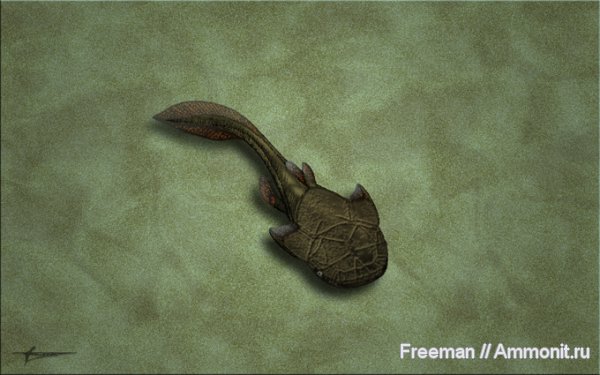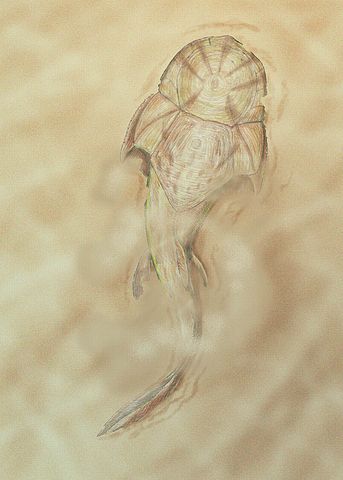
| Palaeos: |  |
Placodermi |
| The Vertebrates | Phyllolepida |
| Page Back | Unit Home | Unit Dendrogram | Unit References | Taxon Index | Page Next |
| Unit Back | Vertebrates Home | Vertebrate Dendrograms | Vertebrate References | Glossary | Unit Next |
|
Abbreviated Dendrogram
Gnathostomata | `--Acanthodii etc (if traditional placement) | Placodermi |?==Acanthothoraci |--Rhenanida `--+--Antiarchi `--+--+--Petalichthyida | `--Ptyctodontida `--+--Arthrodira ? |--+--Actinolepidoidei | | `--Phyllolepida | `--+--Phlyctaenioidei | `--+--Brachythoraci | `--+--Coccosteomorphi | `--+--Pachyosteomorphi | `--Aspinothoracidi `==Acanthodii |--Chondrichthyes `--Osteichthyes |
Contents
Overview |
 The phyllolepid Austrophyllolepis. Life reconstruction © Mikhail Tikhonov, original url |
The order Phyllolepida ("leaf scales") was an order of flattened placoderms found throughout the world, with fossils being found in Devonian strata. Like other flattened placoderms, the phyllolepids were bottom-dwelling predators that ambushed prey. Unlike other flattened placoderms, the phyllolepids were inhabitants of freshwater environments.
Unlike the Rhenanida, the armor of the phyllolepids were made of whole plates, rather than numerous tubercles and scales, and unlike the Petalichthyida, the components of the extraordinarily wide mouth are known. The phyllolepids were considered to be blind, as the eyes are extremely small, so as to suggest that they were vestigial, and that they were placed on the sides of the head, as opposed to visual bottom-dwelling predators, like, say stargazers or flatfish, which have the eyes placed high on top of the head.
Despite having a relatively clear idea of the phyllolepids' lifestyle and anatomy, most fossils consist of fragments of their thoracic armor, and only two genera, Phyllolepis and Austrophyllolepis have been thoroughly studied. From the articulation of the thoracic and head plates, it has been suggested that they are either the sister group of order Arthrodira, or are in fact, a group of highly derived arthrodires. (Long1996) Stanton060924
"Phyllolepis is a member of a poorly-known group of placoderms whose identifying trait is greatly enlarged plates of armor on both head and body. It was probably a rather primitive bottom feeder, much like Arctolepis and Coccosteus."
--Former note on the Royal Tyrell Museum site.
Dismissive statements like this one are intensely irritating. Let us, just for a moment, look at the world from the point of view of Phyllolepis and consider just who, as between the author of that sentence and Phyllolepis, might more accurately be described as a "rather primitive bottom-feeder."
 |
Pennsylvania. Early summer. Mid-morning. Three hundred seventy million years ago. With brisk, liquid authority the river cuts west through a break in the cracked and barren brown foothills of the Taconic Range, its progress a dark procession within a waving crowded corridor of skeletal green lycopsids and giant ferns. They scatter the harsh sun, throwing bits of colored light and shadow skittering over the smooth, dark surface. The bank is steep ochre clay, water-scoured by spring floods and melt from the retreating glaciers to the east. Insects pick delicately through exposed shallow roots. Below the surface, the river bottom is sand and rock and silt, windrows of plant debris, a kaleidoscopic maze of tans and green water plants glimpsed dimly through turbid currents and shifting light.
Phyllolepis hunts here. Not half a meter long, its broad head plates are tan and lumpy as the rock around it, etched with strange concentric ridges housing a light growth of filamentous algae. The algal threads blow and flutter in the currents, further confusing color and form. Now still, flat against the river bottom, it mimics some half-overgrown, long dead mollusk shell. Its long thin tail is an inconspicuous wedge behind, draped with deceptive languor in the shadow of a rock. Its eyes are well forward on the upper surface of the great, flat head. Half-buried in sand, they are small, weak, unblinking.
But the play of light and color, the universe of vision is for others -- foolish, energy-wasting acanthodians and lungfish, easily confused and misled in the dim, murky bottomland. The placoderm's hunt is not a matter of speed and violence. It is a patient game of skill. Quietly, Phyllolepis builds a map of the microcurrents in its shelter. It tastes the world around it, flavored by the million chemical signatures of life and death, spiced and crunchy with electric fields which resonate to the music of muscle and nerve.
Here in the sand is the taste of the burrowing annelid worm - not far, but too old, too deep. There, the mark of some small, plant-climbing gastropod - too small to be worth the expense of capture. Time passes. A swirl of current, an electrical tingle warns of something large approaching, but the shade passes above without incident. And as time passes, Phyllolepis paints, in more and more detail, the complex landscape of current and the shape and texture of the chemical and electrical countryside around it.
Finally, there, beyond the gravel skree below the bank, it feels a slightly mistimed back-current, a hint of deeper, older sand and waste, a sudden bulge in an electrical field. With a minute flick of the tail, Phyllolepis begins to glide, edging up to the bank, anticipating, riding, following, flowing on the complex turbulent flow of current, through the rich carpet of energy and taste. The sense is stronger now. Some incautious crustacean is burrowing too close to the surface. In one huge, lurching dash, Phyllolepis is on it, blasting sand away with the force of its approach, crushing the thin shell with bony tooth plates and swallowing.
The sand settles, the mud is swept away, and Phyllolepis patiently begins to rebuild its map.
 Phyllolepida:
Stensiö (1934). Austrophyllolepis Long (1984), Cobandrahlepis
Young (2005), Phyllolepis Agassiz (1844), Placolepis
Ritchie (1984), Yurammia Young (2005).
Phyllolepida:
Stensiö (1934). Austrophyllolepis Long (1984), Cobandrahlepis
Young (2005), Phyllolepis Agassiz (1844), Placolepis
Ritchie (1984), Yurammia Young (2005).
Range: Middle Devonian (Givetian) to Late Devonian (Famennian) of Antarctica, Australia, Europe, Greenland, North America, Scotland, & Russia. All Famennian except Australia & Antarctica.
Phylogeny: Actinolepidoidei: Actinolepida + *.
Characters: 30-40 cm; eyes reduced, possibly absent; sclerotic ring absent; extensive armor; greatly flattened; nuchal plate enlarged, with width ≥ length [Y05]; nuchal plate surrounded by 4 paired plates plus paranuchal plate bearing postnuchal process [Y05]; trunk armor broad [Y05]; anterior dorsolateral plates with long, narrow exposed area [Y05]; anterior ventral and posterior lateral plates absent [Y05]; anterior ventrolateral plate short & broad [Y05]; ventrolateral plates flat, without lateral laminae & meeting ventromedially with non-overlapping sutures [Y05]; dermal ornament usually (except Yurammia) of conspicuous concentric pattern of raised ridges on plates [Y05]; highly developed lateral line system and probably electroreception.
Image: Phyllolepis from Crystal World.
Links: Faktasider (Norwegian); Phyllolepid placoderms from the Catskill fm.
References: Young (2005) [Y05]. ATW050826.
| Page Back | Unit Home | Page Top | Page Next |
checked ATW0151003; new page MAK111028